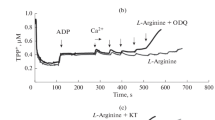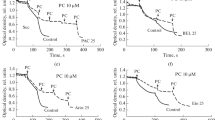Abstract
Oxidation of pyruvate and palmitoylcarnitine in mitochondria is accompanied by the formation of acetyl-CoA, with its possible participation in the acetylation of various proteins and enzymes that may lead to the inhibition of their functions. This paper studies the effect of the excess of these substrates on respiration and induction of mitochondrial permeability transition pore (MPTP) in mitochondria and liver homogenates of healthy, obese, and type 2 diabetic (T2D) rats and mice. Both substrates produced a reversible inhibition of respiration and induced the opening of MPTP sensitive to cyclosporin A. Induction of MPTP in mitochondria was further activated by calcium ions and inhibited by the NO donor SNAP and NAD–a coenzyme and activator of deacetylation reactions. In obese and T2D animals, the opening of MPTP was stimulated by lower concentrations of L-palmitoylcarnitine than in healthy animals. In these pathologies, an activation effect on the MPTP induction was produced by ammonium ions, in the presence of which the concentration of L-palmitoylcarnitine required for the pore opening was reduced more than twofold. In liver homogenates, an added arginine reduced the probability of the MPTP formation. Analysis of mathematical models has shown that, due to the inhibition of pyruvate dehydrogenase kinase (PDK) by pyruvate, phosphorylation of pyruvate dehydrogenase (PDH) is strongly reduced, and this makes it possible to produce acetyl CoA in a wide range of pyruvate concentrations. The data obtained show that excess substrates that produce acetyl-CoA increase the probability of the MPTP opening, especially in pathologies associated with obesity and T2D. The ability of NO and NAD to inhibit MPTP indicates the participation of phosphorylation and acetylation/deacetylation reactions in this process.
Similar content being viewed by others
Abbreviations
- MPTP:
-
mitochondrial permeability transition pore
- T2D:
-
type 2 diabetes
- PDK:
-
pyruvate dehydrogenase kinase
- PC:
-
DL-palmitoylcarnitine
References
Lemasters J.J., Theruvath T.P., Zhong Z., Nieminen A.L. 2009. Mitochondrial calcium and the permeability transition in cell death. Biochim. Biophys. Acta. 1787 (11), 1395–1401.
Bernardi P. 2013. The mitochondrial permeability transition pore: A mystery solved? Front. Physiol. 4, 95.
Rasola A., Bernardi P. 2014. The mitochondrial permeability transition pore and its adaptive responses in tumor cells. Cell Calcium. 56 (6), 437–445.
Hunter D.R., Haworth R.A. 1979. The Ca2+-induced membrane transition in mitochondria. I. The protective mechanisms. Arch Biochem Biophys. 195, 453–459.
Wagner G.R., Hirschey M.D. 2014. Nonenzymatic protein acylation as a carbon stress regulated by sirtuin deacylases. Mol. Cell. 54 (1), 5–16.
Hunter D.R., Haworth R.A. 1979. The Ca2+-induced membrane transition in mitochondria. III. Transitional Ca2+ release. Arch. Biochem. Biophys. 195 (2), 468–477.
Huang J.Y., Hirschey M.D., Shimazu T., Ho L., Verdin E. 2010. Mitochondrial sirtuins. Biochim. Biophys. Acta. 1804 (8), 1645–1651.
He W., Newman J.C., Wang M.Z., Ho L., Verdin E. 2012. Mitochondrial sirtuins: Regulators of protein acylation and metabolism. Trends Endocrinol. Metab. 23 (9), 467–476.
Dynnik V.V., Djafarov R.H. 1986. Regulation of the tricarboxylic acid cycle and ß-oxidation by excess substrates. Biochem. Int. 12 (6), 795–805.
Dynnik V.V., Maevsky E.I., Kosenko E.A., Kaminsky Yu.G. 1987. Stoichiometric traps in the tricarboxylic acid cycle. I. Self-inhibition and triggering phenomena. Biochem. Int. 14 (2), 199–210.
Grishina E.V., Kasymov V.A., Nenov M.N., Berezhnov A.V., Fedotova E.I., Grushin K.S., Dolgachova L.P., Kokoz Yu.M., Zinchenko V.P., Dynnik V.V. 2007. Inhibition of mitochondrial energy by derivatives of coenzyme A (CoA). Toxic effects of saturated fatty acids. Reception and intracellular signaling. Conference Proceedings, Pushchino: ID V. EMA, LLC, p. 215–218.
Lai J.C., Cooper A.J. 1991. Neurotoxicity of ammonia and fatty acids: Differential inhibition of mitochondrial dehydrogenases by ammonia and fatty acyl coenzyme A derivatives. Neurochem. Res. 16 (7), 795–803.
Sugden M.C., Holness M.J. 2002. Therapeutic potential of the mammalian pyruvate dehydrogenase kinases in the prevention of hyperglycaemia. Curr. Drug Targets Immune Endocr. Metabol. Disord. 2 (2), 151–165.
Roche T.E., Hiromasa Y. 2007. Pyruvate dehydrogenase kinase regulatory mechanisms and inhibition in treating diabetes, heart ischemia, and cancer. Cell Mol. Life Sci. 64 (7), 8–830.
Wang J., Kumaran S., Zhou J., Nemeria N.S., Tao H., Kakalis L., Park Y.H., Birkaya B., Patel M.S., Jordan F. 2015. Elucidation of the interaction loci of the human pyruvate dehydrogenase complex E2·E3BP core with pyruvate dehydrogenase kinase 1 and kinase 2 by H/D exchange mass spectrometry and nuclear magnetic resonance. Biochemistry. 54 (1), 69–82.
Johansson C.J., Pettersson G. 1977. Substrate inhibiton by acetyl-CoA in the condensation reaction between oxaloacetate and acetyl-CoA catalyzed by citrate synthase from pig heart. Biochim. Biophys. Acta. 484 (1), 208–215.
Ampuero J., Ranchal I., del Mar Díaz-Herrero M., del Campo J.A., Bautista J.D., Romero-Gó mez M. 2013. Role of diabetes mellitus on hepatic encephalopathy. Metab. Brain Dis. 28 (2), 277–279. doi: 10.1007/s11011-012-9354-2.
Newman J.C., He W., Verdin E. 2011. Mitochondrial protein acylation and intermediary metabolism: Regulation by sirtuins and implications for metabolic disease. J. Biol. Chem. 287 (51), 42436–42443.
Doczi J., Turiák L., Vajda S., Mándi M., Töröcsik B., Gerencser A.A., Kiss G., Konràd C., Adam-Vizi V., Chinopoulos C. 2011. Complex contribution of cyclophilin D to Ca2+-induced permeability transition in brain mitochondria, with relation to the bioenergetic state. J. Biol. Chem. 286 (8), 6345–6353.
Costa A.D., Pierre S.V., Cohen M.V., Downey J.M., Garlid K.D. 2008. cGMP signalling in preand postconditioning: The role of mitochondria. Cardiovasc. Res. 77 (2), 344–352.
Azarashvili T., Odinokova I., Bakunts A., Ternovsky V., Krestinina O., Tyynelä J., Saris N.E. 2014. Potential role of subunit c of F0F1-ATPase and subunit c of storage body in the mitochondrial permeability transition. Effect of the phosphorylation status of subunit c on pore opening. Cell Calcium. 55 (2), 69–77.
Chinopoulos C., Konràd C., Kiss G., Metelkin E., Töröcsik B., Zhang S.F., Starkov A.A. 2011. Modulation of F0F1-ATP synthase activity by cyclophilin D regulates matrix adenine nucleotide levels. FEBS J. 278 (7), 1112–1125.
Author information
Authors and Affiliations
Corresponding author
Additional information
Original Russian Text © E.V. Grishina, M.H. Galimova, R.H. Djafarov, A.I. Sergeev, N.I. Fedotcheva, V.V. Dynnik, 2015, published in Biologicheskie Membrany, 2015, Vol. 32, No. 5–6, pp. 319–327.
Rights and permissions
About this article
Cite this article
Grishina, E.V., Galimova, M.H., Djafarov, R.H. et al. Induction of cyclosporine-sensitive mitochondrial permeability transition pore by substrates forming acetyl-CoA under normal conditions and in type 2 diabetes. Biochem. Moscow Suppl. Ser. A 10, 11–18 (2016). https://doi.org/10.1134/S1990747815050049
Received:
Published:
Issue Date:
DOI: https://doi.org/10.1134/S1990747815050049




